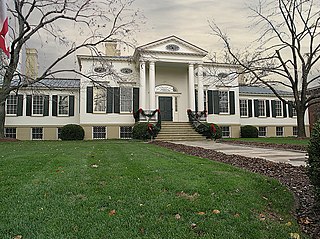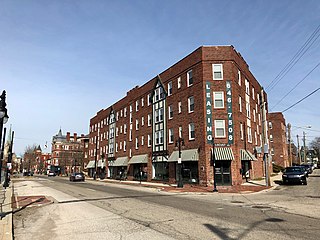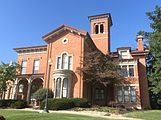
Mount Auburn Cemetery is the first rural, or garden, cemetery in the United States, located on the line between Cambridge and Watertown in Middlesex County, Massachusetts, 4 miles (6.4 km) west of Boston. It is the burial site of many prominent Boston Brahmins, as well as being a National Historic Landmark.

WLWT is a television station in Cincinnati, Ohio, United States, affiliated with NBC and owned by Hearst Television. The station's studios are located on Young Street, and its transmitter is located on Chickasaw Street, both in the Mount Auburn neighborhood of Cincinnati.

Mount Washington is a community on the east side of Cincinnati, Ohio, United States. As one of Cincinnati's 52 neighborhoods, Mount Washington lies within the city corporation limits, and borders the neighborhoods of California and the East End, as well as unincorporated Anderson Township, Hamilton County, Ohio. It is served by the 24, 30, and 81 Metro bus routes.

William Howard Taft National Historic Site is a historic house at 2038 Auburn Avenue in the Mount Auburn Historic District of Cincinnati, Ohio, a mile (1.6 km) north of Downtown. It was the birthplace and childhood home of William Howard Taft, the 27th president and the 10th chief justice of the United States. It is a two-story Greek Revival house built circa 1845.

The Taft Museum of Art is a fine art collection in Cincinnati, Ohio. It occupies the 200-year-old historic house at 316 Pike Street. The house – the oldest domestic wooden structure in downtown Cincinnati – was built about 1820 and housed several prominent Cincinnatians, including Martin Baum, Nicholas Longworth, David Sinton, Anna Sinton Taft and Charles Phelps Taft. It is on the National Register of Historic Places listings, and is a contributing property to the Lytle Park Historic District.

Spring Grove Cemetery and Arboretum is a nonprofit rural cemetery and arboretum located at 4521 Spring Grove Avenue, Cincinnati, Ohio. It is the third largest cemetery in the United States, after the Calverton National Cemetery and Abraham Lincoln National Cemetery and is recognized as a US National Historic Landmark.

Mount Lookout, Ohio is one of the Eastern neighborhoods of Cincinnati, just northwest of Linwood and overlooking the Ohio River valley.
This is relating to the culture of Cincinnati, Ohio.

East Walnut Hills is a neighborhood on the Southeast side of Cincinnati, Ohio. The population was 4,103 at the 2020 census.

Prospect Hill Historic District is located on a hillside outside of downtown Cincinnati, Ohio, United States. It is part of the Mount Auburn neighborhood of Cincinnati. Prospect Hill is bounded by the following streets, Liberty, Sycamore, Boal and Highland. Prospect Hill is sometimes called locally "Liberty Hill".

The Alexandra is a historic apartment building located on Gilbert Avenue in the Walnut Hills neighborhood of Cincinnati, Ohio, United States. Constructed in 1904 as the neighborhood's first large apartment building, it was one of many such buildings constructed for the real estate management firm of Thomas J. Emery's Sons. It has been named a historic site.

The Gorham A. Worth House is a historic residence in the Mount Auburn neighborhood of Cincinnati, Ohio, United States. Located atop a hill along Auburncrest Avenue, the house was built in 1819 in a version of the Federal style of architecture.

William Howard Doane was a manufacturer, inventor, hymn writer, choral director, church leader and philanthropist. He composed over 2,000 church hymns. More than seventy patents are credited to him for innovations in woodworking machinery. His philanthropy led to the renaming of the Granville Academy, as the Doane Academy, a boys' and girls' private preparatory school associated with Denison University in Granville, Ohio, where he was a major benefactor.

Brattle Street in Cambridge, Massachusetts, called the "King's Highway" or "Tory Row" before the American Revolutionary War, is the site of many buildings of historic interest, including the modernist glass-and-concrete building that housed the Design Research store, and a Georgian mansion where George Washington and Henry Wadsworth Longfellow both lived, as well as John Vassall and his seven slaves including Darby Vassall. Samuel Atkins Eliot, writing in 1913 about the seven Colonial mansions of Brattle Street's "Tory Row," called the area "not only one of the most beautiful but also one of the most historic streets in America." "As a fashionable address it is doubtful if any other residential street in this country has enjoyed such long and uninterrupted prestige."

Lytle Park Historic District is a historic district in Cincinnati, Ohio, United States. Roughly bounded by 3rd, 5th, Sycamore, Commercial Sq., and Butler Sts. in downtown Cincinnati, it centers on Lytle Park.
The WLWT TV Tower is a free-standing lattice tower with triangular cross section used by WLWT located in Cincinnati, Ohio. Built in 1978, it replaced the original 570-foot tall WLWT tower built in 1948 at the same site on Chickasaw Street, in the Mount Auburn neighborhood of Cincinnati. The new tower stands 289.6 m (950 ft) tall, one of four that rise above 900 feet in the city and is among the tallest lattice towers in the world.






















